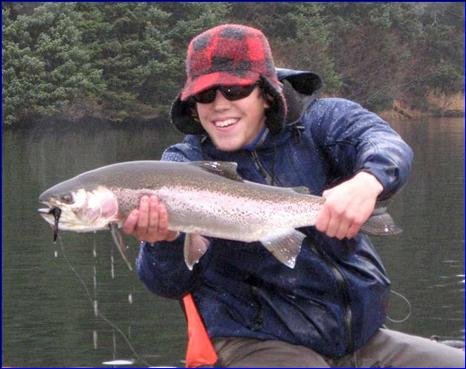By Allison Arteaga Soergel*
Santa Cruz, USA – This month, two faculty members from UC Santa Cruz’s Environmental Studies Department won a $496,000 grant from the U.S. Department of Agriculture to support innovations in sustainable aquaculture. The funding will help principal investigator Pallab Sarker, an associate research professor and sustainable aquaculture and fish nutrition expert, and co-principal investigator professor Anne Kapuscinski, a sustainability science and policy expert, in their efforts to develop a more ocean-friendly feed formula for farm-raised rainbow trout.
They hope to use proteins and oils derived from a combination of marine microalgae to replace traditional fishmeal and fish oil ingredients sourced from wild-caught forage fish like anchovies, sardines, and herring. Currently, the aquaculture industry’s demand for forage fish, in the form of fishmeal and fish oil, diverts these fish away from providing natural food resources for wild animals within ocean food webs. That’s why the research team is looking for ways to “uncouple” aquaculture feeds from ocean food webs by developing new feed formulations that don’t rely on ingredients from wild fish.
Sarker and Kapuscinski published a major breakthrough on this front in November: the first fully fish-free feed formula for farmed tilapia to demonstrate across-the-board gains in sustainability, fish growth, economic viability, and nutritional value for human consumers. Now, the researchers are hoping to replicate their success with rainbow trout. That goal is especially important since trout and their relatives, salmon, are some of aquaculture’s largest consumers of fishmeal and fish oil. But getting these particular species onto a fish-free diet will be challenging.
Unlike tilapia, trout and salmon are natural predators that evolved to eat other fish. Marine microalgae are much lower down in the ocean food chain, however, they’re still part of the same systems of nutrient and energy transfer. That gives researchers hope that the right combination of microalgae species could potentially match the nutritional value of fish-based ingredients. Their experiments will be aimed at finding the right fit for the needs of rainbow trout.
“We know it will be harder to achieve a cost-viable diet that has no fish ingredients than it was for tilapia,” said Kapuscinski. “We won the grant because we have promising ideas with microalgae to make a big advance. Even if we don’t achieve a fully fish-free diet for farmed trout, achieving further reduction in the use of fishmeal and fish oil would be a big accomplishment. And that could serve as a model for salmon farming, too.”
The new USDA funding for this project will complement a prior award of $120,000 from California Sea Grant. Together, these grants will allow researchers to expand the scope and timeline of their experiments. In particular, Sarker said he’s excited that the new funding will allow him to test out a microalgal species he hasn’t worked with before. It’s a variety that is now being produced commercially for use in omega-3 dietary supplements, so the team will plan to utilize the protein-rich algal biomass leftover after the omega-3 oils are extracted.
Researchers expect to start experimenting soon with various processing methods for manufacturing feed using these and other ingredients. They’ll also test the digestibility of their formulas. Of course, this will require some eager participants to chow down on the new feed, so juvenile rainbow trout will be stocked into the team’s newly-constructed recirculating aquaculture facility at the UCSC Farm. These will be the first fish to take up residence in the new facility. Their arrival will be a big moment for researchers.
“We have been facing unprecedented challenges this year with the COVID-19 lockdowns and then the California fires, all of which has seriously affected our project timelines,” said Sarker. “Now, our recirculating aquaculture system has been prepared to get live rainbow trout for our first experiment in our new lab, and I’m truly thrilled about it.”
Stay Always Informed
Join our communities to instantly receive the most important news, reports, and analysis from the aquaculture industry.
Sarker said he also looks forward to involving UC Santa Cruz students in the lab’s research, once it’s safe to do so. Currently, social distancing protocols limit the number of people who can be in the lab at a given time, but in the future, Sarker hopes to bring students to visit the facility, where they could gain practical experience with collecting research data and caring for fish.
Students can also learn about the lab’s sustainability practices. Kapuscinski said the facility’s location at the UCSC Farm was carefully selected to model how aquaculture and agriculture can be integrated to reduce waste. Water periodically removed from the recirculating aquaculture tanks contains beneficial nutrients for plants and will be used as irrigation and fertilizer for the organic farm managed by the Center for Agroecology and Sustainable Food Systems (CASFS).
With a new facility up and running and new grant funding in hand, the research team members say they are feeling optimistic about the road ahead.
“I am delighted to conduct this line of research at UCSC,” Sarker said. “This is a tremendous opportunity for our society to shift away from unsustainable practices to sustainable aquaculture production. I think we can do better. We have an obligation to do better for our planet.”
*Source: UC SANTA CRUZ
Editor at the digital magazine AquaHoy. He holds a degree in Aquaculture Biology from the National University of Santa (UNS) and a Master’s degree in Science and Innovation Management from the Polytechnic University of Valencia, with postgraduate diplomas in Business Innovation and Innovation Management. He possesses extensive experience in the aquaculture and fisheries sector, having led the Fisheries Innovation Unit of the National Program for Innovation in Fisheries and Aquaculture (PNIPA). He has served as a senior consultant in technology watch, an innovation project formulator and advisor, and a lecturer at UNS. He is a member of the Peruvian College of Biologists and was recognized by the World Aquaculture Society (WAS) in 2016 for his contribution to aquaculture.



